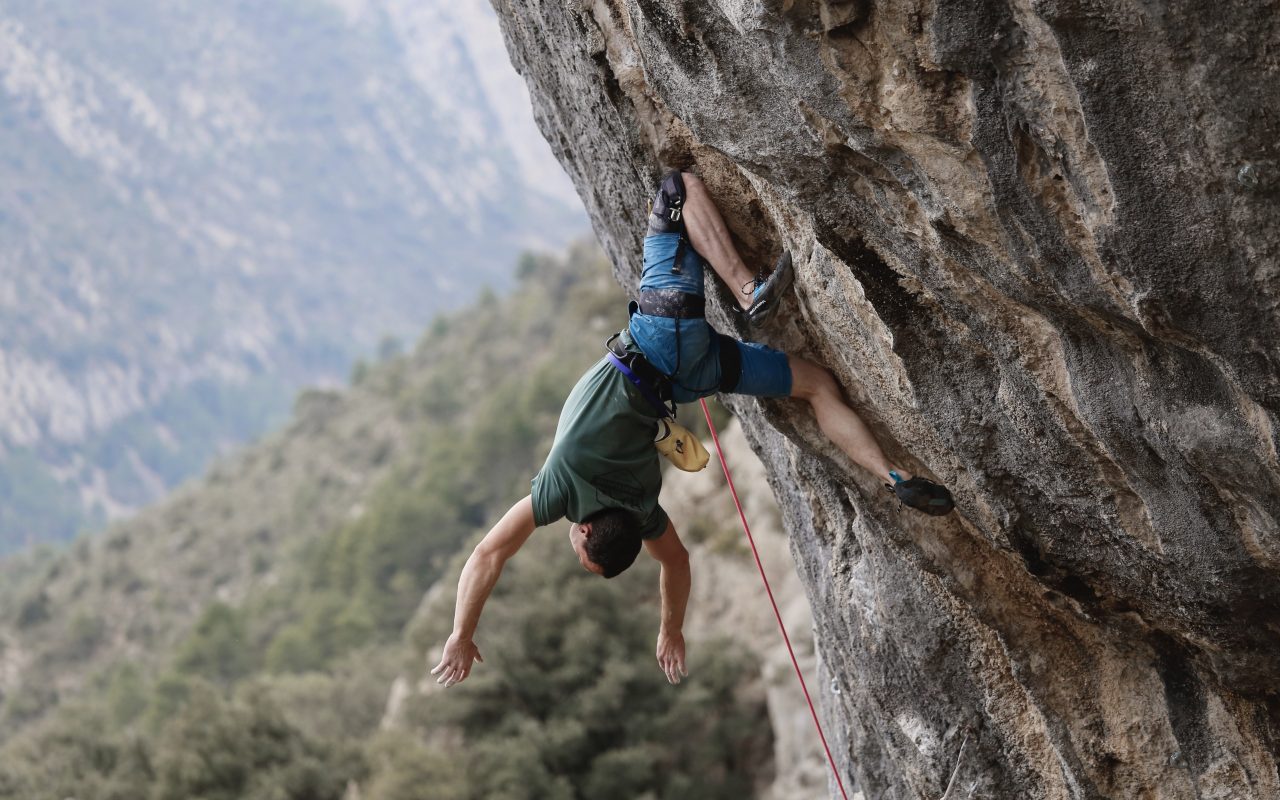Falling is not something climbers traditionally train for or even think about until they have to. SCARPA athlete Angus Kille thinks we should!
In this blog Angus tells us how important falling is in training and how it can help with your climbing.
As climbers, we have a bit of a mixed relationship with falling. Despite its constant presence in climbing, falling is not an area we’ve traditionally trained, or paid a great deal of attention to. In fact, many climbers have actively ignored falling throughout their climbing lives. So what’s going on?
It might be a legacy of the ‘leader doesn’t fall’ maxim, or a reflection of the nuanced, sticky nature of psychology, or just a symptom of one of our most primary fears; I won’t speculate why, but working on falling hasn’t made it into mainstream climbing culture. Of course, plenty of climbers have a great relationship with falling, and this is testament to how we can ‘unlearn’ a fear that almost all of us have. However, without reliable training practices, we’re either expecting climbers to be exceptionally resilient by nature, or to fluke their way through graduated exposure without having the kind of scary experiences that could easily put them off climbing altogether.

That’s the thing about training falling: it’s really easy to get wrong, and the basic principles go against our common intuitions. What’s more, we can learn fear through ‘one trial learning’, which means we only need one bad experience to create strong fear associations. So there are loads of climbers out there who are having much less fun whilst climbing because they’re somewhat scared to fall, and plenty of more who are no longer climbers at all. Being a climber, instructor and mental training coach, I see just how terribly common this is every time I’m at the wall or crag.
Quite a lot of climbers don’t feel they have fear of falling because their fear is ‘rational’ – that is, it’s unsafe to fall, so not wanting to fall makes sense. But whilst that fear might be rational, reasonable or completely understandable, that doesn’t mean that training falling isn’t worthwhile. Falling is a skill, and practising it makes falling safer. Practising falling lets us know which falls are safe, how to make them safer and it can turn unsafe falls into safe ones. A surprisingly large proportion of climbers still find theoretically ‘safe’ falls scary, whether they’re aware of their fear or not.
This brings me to the most critical thing climbers get wrong with fall practice. It’s often assumed that if a fall is physically safe, then it is safe, and training falling is as simple as… falling. Firstly, falling itself is a skill that needs to be practised, and it’s not as safe if we don’t fall well. Secondly, we don’t unlearn fear by taking falls that actually feel scary to us, we unlearn fear by gradually taking falls that are just outside our comfort zone. This is graduated exposure therapy, and it’s a very well researched area of psychology.

So many climbers assume that they just need to ‘push through’, grit their teeth and take the fall to become comfortable with it. But even if that fall is physically ‘safe’, it’s not psychologically safe if it’s that stressful, meaning that we ingrain fear or even risk mild trauma. Just to repeat that: having scary experiences of falling makes falling scarier for us; taking a huge fall is very unlikely to cure fear of falling, just as jumping into a bath of tarantulas is unlikely to cure fear of spiders (it’s far more likely to give us trauma). What’s more, so many climbers are not aware of their fear around climbing because we’ve normalised stress in society, and climbers have normalised stress in climbing, because that’s what climbing feels like for them and they’ve dealt with it by ignoring it.
Whilst this approach has worked for some, for most it has left them enjoying climbing less than they could have (and of course underperforming), and it’s excluded others from our sport altogether. The other approach people take is to avoid falling altogether, but this does not make us more comfortable with falling and generally reinforces the idea that falling is a scary thing. You might have experienced this after lockdown – your comfort zone is usually smaller after not going climbing for a long time; the same applies to falling.
I think the psychological side of climbing is what makes it so interesting. Falling is a part of climbing, whether we fall or not. The psychological side of our sport is what we can transfer to the rest of our lives, whereas it’s not very often my finger strength comes in handy outside of my climbing life. A little more attention to climbing’s ever-present shadow, and some safer practices around it, would make climbing more enjoyable and more rewarding.
So there’s my case for training falling (and the psychological side of climbing) even if it’s not the norm for you. There’s a very good chance it’ll improve your performance and enjoyment in climbing, and if you’ve not engaged in mental training much before, it’s probably very low-hanging fruit for you. If you’re going to start training falling, make sure you get some high-quality information on this, and start easy!
About Angus
Angus has been climbing for 15 years, and has climbed 9a on sport, E9 on trad, 8A boulders and many big walls. Angus is also an instructor and coach, you can find out more about Angus’ coaching here: strongmindclimbing.com/team/angus-kille



